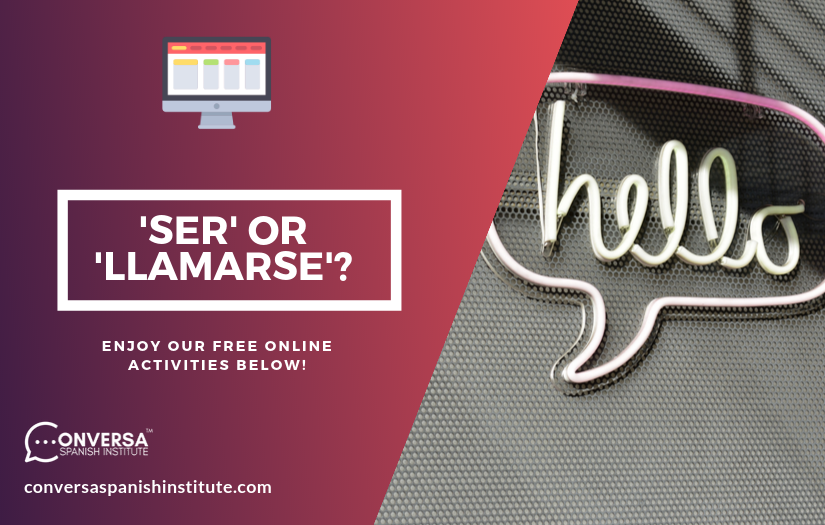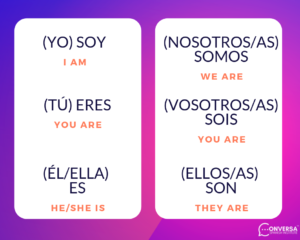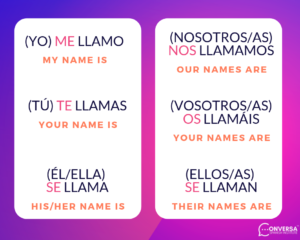- [email protected]
- +34 961258767
- Av. del Marqués de Sotelo 3, Piano 2, Porta 4, 46002 Valencia
Centro accreditato dall'Instituto Cervantes
Centro accreditato dall'Instituto Cervantes

Nelle voci precedenti abbiamo parlato di come presentarsi in spagnolo e diverse frasi che puoi usare per iniziare un'introduzione di successo. Oggi, però, andremo un po' più a fondo e conosceremo il concetto di grammatica behind introductions. Let’s review the Spanish verbs “ser” and “llamarse”.
Proprio come in inglese, le strutture più comuni sono “soy” (Io sono) o “me llamo” (Il mio nome è). Molto semplice. Ma cosa succede se vuoi chiedere all'altra persona il suo nome? O se vuoi presentare qualcun altro? Per farlo, dovrai conoscere tutte le forme di questi verbi.
If you are learning Spanish you probably know that verbs are trickier than in English. The verb “ser” (essere) is irregular and its form varies considerably depending on the subject (I, you, them, etc). “Llamarse” (literally da chiamare), on the other hand, is a regular verb, so if you know the word endings for regular verbs, you won’t find much difficulty. But it is a reflexive verb, meaning it comes with the pronoun “se” which also changes. Don’t worry if you find this explanation a bit confusing, we will explain in detail how verbs work in Spanish soon, so let’s now focus on Ser vs Llamarse.
Come già detto, queste sono le frasi abituali che possiamo utilizzare:
So what if you want to introduce someone else? Well let’s see all the forms:


NOTA: Now, we have talked about “llamarse” as “to be called”, but since this is not a structure that you typically find in English, the most fitting translation is “my/your/her… name is”.
Se ti stai chiedendo perché i pronomi soggetto (io, tu, ecc.) sono tra parentesi, è perché non sono necessari, in quanto capiamo di chi stiamo parlando grazie al verbo terminare.
Ad esempio, una presentazione molto semplice tra tre persone potrebbe andare in questo modo:
Come puoi vedere, there isn’t really a difference in meaning or style between the verbs “ser” and “llamarse”. Both are perfectly adequate in any situation. Maybe “¿Cómo te llamas?” is more appropriate than “who are you?”, as the meaning behind “llamarse” is specific to names and that question may sound rude, depending on the tone or situation.
Did you get any of that? Give yourself time, and you’ll master Spanish in the blink of an eye!
Don’t forget to practice with this attività online gratuita e continua a imparare lo spagnolo!
| Cookie | Duración | Descripción |
|---|---|---|
| cookielawinfo-checkbox-analytics | 11 mesi | Questo cookie è impostato dal plugin GDPR Cookie Consent. Il cookie viene utilizzato per memorizzare il consenso dell'utente per i cookie della categoria "Analytics". |
| cookielawinfo-checkbox-funzionale | 11 mesi | Il cookie è impostato dal GDPR cookie consent per registrare il consenso dell'utente per i cookie della categoria "Funzionali". |
| cookielawinfo-checkbox-necessario | 11 mesi | Questo cookie è impostato dal plugin GDPR Cookie Consent. Il cookie viene utilizzato per memorizzare il consenso dell'utente per i cookie della categoria "Necessario". |
| cookielawinfo-checkbox-altri | 11 mesi | Questo cookie è impostato dal plugin GDPR Cookie Consent. Il cookie viene utilizzato per memorizzare il consenso dell'utente per i cookie della categoria "Altro". |
| cookielawinfo-checkbox-prestazioni | 11 mesi | Questo cookie è impostato dal plugin GDPR Cookie Consent. Il cookie viene utilizzato per memorizzare il consenso dell'utente per i cookie della categoria "Performance". |
| politica_cookie_vista | 11 mesi | Il cookie è impostato dal plugin GDPR Cookie Consent ed è utilizzato per memorizzare se l'utente ha acconsentito o meno all'uso dei cookie. Non memorizza alcun dato personale. |
Compila il modulo sottostante e il nostro team di ammissione ti risponderà entro 24-48 ore.